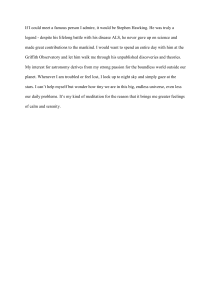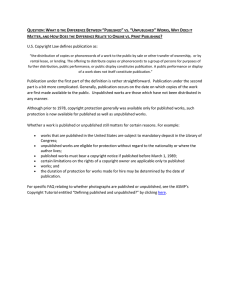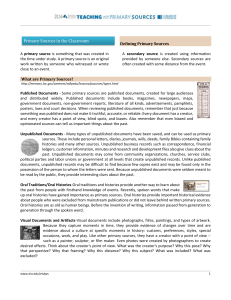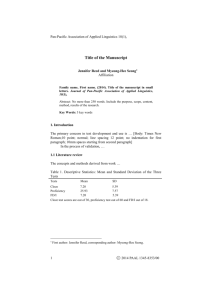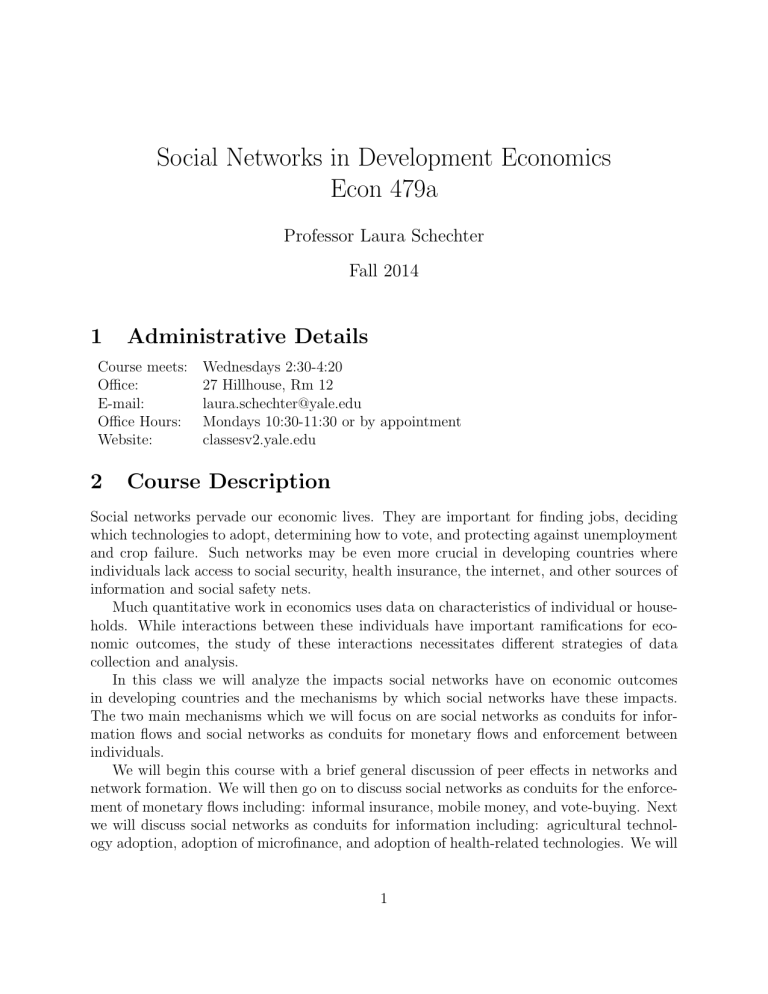
Social Networks in Development Economics Econ 479a Professor Laura Schechter Fall 2014 1 Administrative Details Course meets: Wednesdays 2:30-4:20 Office: 27 Hillhouse, Rm 12 E-mail: laura.schechter@yale.edu Office Hours: Mondays 10:30-11:30 or by appointment Website: classesv2.yale.edu 2 Course Description Social networks pervade our economic lives. They are important for finding jobs, deciding which technologies to adopt, determining how to vote, and protecting against unemployment and crop failure. Such networks may be even more crucial in developing countries where individuals lack access to social security, health insurance, the internet, and other sources of information and social safety nets. Much quantitative work in economics uses data on characteristics of individual or households. While interactions between these individuals have important ramifications for economic outcomes, the study of these interactions necessitates different strategies of data collection and analysis. In this class we will analyze the impacts social networks have on economic outcomes in developing countries and the mechanisms by which social networks have these impacts. The two main mechanisms which we will focus on are social networks as conduits for information flows and social networks as conduits for monetary flows and enforcement between individuals. We will begin this course with a brief general discussion of peer effects in networks and network formation. We will then go on to discuss social networks as conduits for the enforcement of monetary flows including: informal insurance, mobile money, and vote-buying. Next we will discuss social networks as conduits for information including: agricultural technology adoption, adoption of microfinance, and adoption of health-related technologies. We will 1 end by looking at interactions which may mix both information and enforcement, including default behavior in microfinance and job referrals. Goals of the class: • Appreciate the special nature of social network data. • Learn how to use social network data in statistical analysis. • Understand the application of social network analysis to the study of developing countries. • Develop an understanding of the research process. • Learn how to critically assess the statistics used in empirical studies and to judge the veracity of their conclusions. 3 Prerequisites Intermediate Microeconomics (Econ 121 or 125) and Econometrics (Econ 131 or 135). 4 Participation Class discussion is integral to the learning process and will be part of student evaluations. Please come to class prepared! To encourage you to be prepared you will be asked to hand in a worksheet regarding the readings for each day of class. The course is aimed at being challenging and thought-provoking with a focus on thinking through how best to analyze the data. Often there is not a single right answer. Each week, students will be required to read three academic papers (or two very short papers on the first day of class). For some weeks additional optional readings are also listed. For each day of class, one or two students will prepare to lead the discussion of the papers. We will consider the questions that are being asked, the methods and data being used, and the key findings and their implications. 5 Assignments • Class participation (15% of final grade): Students are expected to come to every class and participate in the class discussions. In addition, students are expected to complete a short worksheet on each of the week’s assigned papers, noting the paper’s contribution, empirical approach, and limitations. These should be handed in at the beginning of class. These will not be individually graded, but they will count towards your class participation grade. 2 • Lead class discussion (20% of final grade): Each student, either individually or in pairs, will be responsible for presenting one to two of the papers and leading the discussion. The discussion should last 15-20 minutes and should center on the contribution of the paper(s), issues with the analysis, relationship with other course readings, and any questions that are left open. Students will need to meet with the instructor to prepare their presentation. • Identify a research question (10% of final grade): Each student will identify a research question related to social networks in developing countries. These one page papers will motivate your question’s importance and provide some intuition for a possible answer. You should find and discuss two or three related academic papers when making your case. I recommend perusing the entire syllabus for ideas. Due: September 17 in class. • Mid-term draft of a 5-7 page proposal of an empirical project (20% of final grade): Each student will turn his or her research question into the first half of a research proposal. This should contain a literature review that places the project in context, a fleshed out hypothesis, and an economic model that formalizes your intuition. We will discuss my expectations in detail during class. Due: Friday, October 17, 5pm. • Final 15-20 page research proposal (35% of final grade): The final paper includes the clear development of a research question, a literature review, a hypothesis, an economic model, a detailed estimation approach, and a discussion of the primary data source that will be used. You need to incorporate any feedback you receive on your midterm draft. Students are encouraged to do some preliminary data description and analysis, but this is not required. Due: Wednesday, December 10, 5pm. 6 Academic Integrity We will review what plagiarism is, how to identify it, and how to avoid plagiarizing in our own research. We will look at examples of direct and more subtle forms of plagiarism and stress the importance of integrity in academic research. If you do not understand or are uncertain about what constitutes plagiarism, please ask. To read more about what constitutes plagiarism, please read this website of the Yale College Writing Center: “Understanding and Avoiding Plagiarism”. Any cases of suspected plagiarism will be reported directly to the appropriate dean, and documented plagiarism will result in a complete loss of credit on the assignment. 3 7 Course Outline and Readings If you click on the title of any of the papers below it should take you directly to the paper. You may only be able to access these papers when you are logging on from a campus computer due to copyright issues. When I wrote this syllabus all of the links worked. Please let me know if any of them seem to be acting funny throughout the semester. You are required to do all readings which are not marked “Optional”. The readings are all quite excellent, and discussing them in class is not a substitute for reading them yourself! 1. (8/27): Peer Effects • Christakis, N. A. & J.H. Fowler (2007), “The Spread of Obesity in a Large Social Network over 32 Years,” New England Journal of Medicine 357(4): 370-379. • Cohen-Cole, E. & J.M. Fletcher (2008), “Detecting Implausible Social Network Effects in Acne, Height, and Headaches: Longitudinal Analysis,” British Medical Journal 337-341. • [Optional] Manski, C. (1993), “Identification of Endogenous Social Effects: The Reflection Problem,” Review of Economic Studies 60(3): 531-542. 2. (9/3): Network Formation • Krishnan, P. & E. Sciubba (2009), “Links and Architecture in Village Networks,” Economic Journal 119(537): 917-949. • Boardman, J.D., B.W. Domingue, & J.M. Fletcher (2012), “How Social and Genetic Factors Predict Friendship Networks,” Proceedings of the National Academy of Sciences 109(43): 17377-17381. • Comola, M. & S. Prina (2014), “Do Interventions Change the Network? A Dynamic Peer Effect Model Accounting for Network Changes,” Unpublished Working Paper. • [Optional] Comola, M. & M. Fafchamps (2013), “Testing Unilateral and Bilateral Link Formation,” Economic Journal, Forthcoming. 3. (9/10): Transfer Networks - Informal Insurance in the Real World • Dercon, S. & J. DeWeerdt (2006), “Risk-Sharing Networks and Insurance Against Illness,” Journal of Development Economics 81(2): 337-356. • Angelucci, M. & G. De Giorgi (2009), “Indirect Effects of an Aid Program: How do Cash Injections Affect Ineligibles’ Consumption?,” American Economic Review 99(1): 486-508. • Karlan, D., M. Möbius, T. Rosenblat, & A. Szeidl (2009), “Trust and Social Collateral,” Quarterly Journal of Economics 124(3): 1307-1361. 4 4. (9/17): Transfer Networks - Informal Insurance in Games • Barr, A. & G. Genicot (2008), “Risk Sharing, Commitment, and Information: An Experimental Analysis,” Journal of the European Economic Association 6(6): 1151-1185. • Breza, E., A. Chandrasekhar, & H. Larreguy (2013), “Social Structure and Institutional Design: Evidence from a Lab Experiment in the Field,” Unpublished Working Paper. • Chandrasekhar, A., C. Kinnan, & H. Larreguy (2014), “Social Networks as Contract Enforcement: Experimental Evidence from 34 Indian Villages,” Unpublished Working Paper. • [Optional] Chandrasekhar, A., C. Kinnan, & H. Larreguy (2011), “Information, Networks and Informal Insurance: Evidence from a Lab Experiment in the Field,” Unpublished Working Paper. 5. (9/24): Transfer Networks - Altruistic Giving in Games • Ligon, E. & L. Schechter (2012), “Motives for Sharing in Social Networks,” Journal of Development Economics 99(1): 13-26. • Binzel, C. & D. Fehr (2013), “Giving and Sorting Among Friends: Evidence from a Lab-in-the-Field Experiment,” Economics Letters, 121(2): 214-217. • Batista, C., D. Silverman, & D. Yang (2014), “Directed Giving: Evidence from an Inter-Household Transfer Experiment,” Unpublished Working Paper. • [Optional] Leider, S., Möbius, M.M., Rosenblat, T., & Do, Q.-A. (2009), “Directed Altruism and Enforced Reciprocity in Social Networks,” Quarterly Journal of Economics 124(4): 1815-1851. 6. (10/1): Transfer Networks - Mobile Money • Eagle, N., A. Pentland, & D. Lazer (2009), “Inferring Friendship Network Structure by Using Mobile Phone Data,” PNAS 106(36): 15274-15278. • Blumenstock, J., N. Eagle, & M. Fafchamps (2013), “Motives for Mobile PhoneBased Giving: Evidence in the Aftermath of Natural Disasters,” Unpublished Working Paper. • Jack, W., A. Ray, & T. Suri (2013), “Transaction Networks: Evidence from Mobile Money in Kenya,” American Economic Review (P & P) 103(3): 356-361. 7. (10/8): Transfer Networks - Vote Buying • Cruz, C. (2013), “Social Networks and the Targeting of Illegal Electoral Strategies,” Unpublished Working Paper. 5 • Finan, F., H. Larreguy, & L. Schechter (2014), “Vote Buying and Networks: Information, Enforcement or Both?,” Unpublished Working Paper. • Schaffer, J. & A. Baker (2014), “Clientelism as Persuasion-Buying: Evidence from Latin America,” Unpublished Working Paper. • [Optional] Calvo, E. & M.V. Murillo (2013), “When Parties Meet Voters: Assessing Political Linkages Through Partisan Networks and Distributive Expectations in Argentina and Chile,” Comparative Political Studies 46(7): 851-882. 8. (10/15): Transfer Networks - Other Forms of Corruption • Fisman, R. (2001), “Estimating the Value of Political Connections,” American Economic Review 91(4): 1095-1102. • Khwaja, A.I. & A. Mian (2005), “Do Lenders Favor Politically Connected Firms? Rent Provision in an Emerging Financial Market,” Quarterly Journal of Economics 120(4): 1371-1411. • Fafchamps, M. & J. Labonne (2013), “Do Politicians’ Relatives Get Better Jobs? Evidence from Municipal Elections in the Philippines,” Unpublished Working Paper. 9. (10/29): Information Networks - General • Chandrasekhar, A., H. Larreguy, & J.P. Xandri (2012), “Testing Models of Social Learning on Networks: Evidence from a Framed Field Experiment,” Unpublished Working Paper. • Alatas, V., A. Banerjee, A. Chandrasekhar, R. Hanna, & B. Olken (2014), “Network Structure and the Aggregation of Information: Theory and Evidence from Indonesia,” Unpublished Working Paper. • Banerjee, A., A. Chandrasekhar, E. Duflo, & M.O. Jackson (2014), “Gossip: Identifying Central Individuals in a Social Network,” Unpublished Working Paper. 10. (11/5): Information Networks - Agricultural Technology Adoption • Bandiera, O. & I. Rasul (2006), “Social Networks and Technology Adoption in Northern Mozambique,” Economic Journal 116(514): 869-902. • Conley, T. & C. Udry (2010), “Learning About a New Technology: Pineapple in Ghana,” American Economic Review 100(1): 35-69. • Maertens, A. (2014), “Who Cares What Others Think (or Do)? Social Learning, Social Pressures, and Cotton Farming in India,” Unpublished Working Paper. • [Optional] Emerick, K. (2013), “The Efficiency of Trading in Social Networks: Experimental Measures from India,” Unpublished Working Paper. 6 • [Optional] Ben Yishay, A. & A.M. Mobarak (2014), “Social Learning and Communication,” Unpublished Working Paper. 11. (11/12): Information Networks - Other Technology Adoption • Miguel, E. & M. Kremer (2007), “The Illusion of Sustainability,” Quarterly Journal of Economics 122(3): 1007-1065. • Banerjee, A., A.G. Chandrasekhar, E. Duflo, & M.O. Jackson (2013), “The Diffusion of Microfinance,” Science 341(6144). [Please also read supplementary materials here.] • Miller, G. & A.M. Mobarak (2014), “Learning about New Technologies through Social Networks: Experimental Evidence on Non-Traditional Stoves in Bangladesh,” Marketing Science Forthcoming. • [Optional] Oster, E. & R. Thornton (2012), “Determinants of Peer Effects in Menstrual Cup Take-Up,” Journal of the European Economic Association 10(6): 1263-1293. 12. (11/19): Transfers or Information? - Credit and Default Guest lecture by Professor Nicholas Christakis. • Karlan, D. (2007), “Social Connections and Group Banking,” Economic Journal 117(517): 52-84. • Bryan, G., D. Karlan, & J. Zinman (2013), “Referrals: Peer Screening and Enforcement in a Consumer Credit Field Experiment,” Unpublished Working Paper. • Karlan D. & X. Gine (2014), “Group versus Individual Liability: Short and Long Term Evidence from Philippine Microcredit Lending Groups,” Journal of Development Economics 107: 65-83. • [Optional] Karlan D., M.M. Möbius, T.S. Rosenblat, & A. Szeidl (2010), “Measuring Trust in Peruvian Shantytowns,” Unpublished Working Paper. 13. (12/3): Transfers or Information? - Finding a Job • Munshi, K. (2003), “Networks in the Modern Economy: Mexican Migrants in the U. S. Labor Market,” Quarterly Journal of Economics 118(2): 549-599. • Beaman, L. (2012), “Social Networks and the Dynamics of Labour Market Outcomes: Evidence from Refugees Resettled in the U.S.,” Review of Economic Studies 79(1): 128-161. • Beaman, L. & J. Magruder (2012), “Who gets the Job Referral? Evidence from a Social Networks Experiment,” American Economic Review 102(7): 3574-3593. • [Optional] Beaman, L., N. Keleher, & J. Magruder (2013), “Do Job Networks Disadvantage Women? Evidence from a Recruitment Experiment in Malawi,” Unpublished Working Paper. 7



